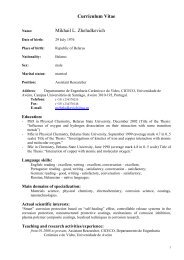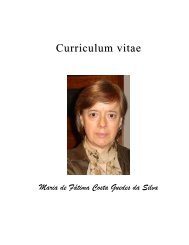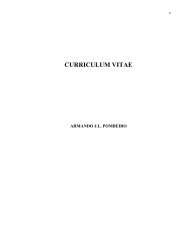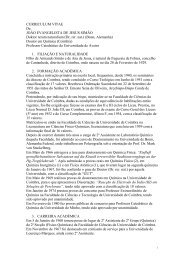XII Iberian Meeting of Electrochemistry XVI Meeting of the ...
XII Iberian Meeting of Electrochemistry XVI Meeting of the ...
XII Iberian Meeting of Electrochemistry XVI Meeting of the ...
Create successful ePaper yourself
Turn your PDF publications into a flip-book with our unique Google optimized e-Paper software.
<strong>XII</strong> <strong>Iberian</strong> <strong>Meeting</strong> <strong>of</strong> <strong>Electrochemistry</strong> & <strong>XVI</strong> <strong>Meeting</strong> <strong>of</strong> <strong>the</strong> Portuguese Electrochemical Society PD 02<br />
Copper corrosion in soils contaminated with chloride ions<br />
Carla Barradas Dias 1 , M. M. M. Neto 1,2 , I. T. E. Fonseca 1<br />
1 CCMM, Departamento de Química e Bioquímica da Universidade de Lisboa, Campo Grande<br />
Ed C8,1749-016 Lisboa, Portugal<br />
2 UIQA, Instituto Superior de Agronomia, TU Lisbon, Tapada da Ajuda, 1349-017 Lisboa, Portugal<br />
carlabarradasdias@gmail<br />
Soils are, in general, very complex matrices; physical conditions (pH, porosity, humidity<br />
degree, oxygenation and conductivity, among o<strong>the</strong>rs) and <strong>the</strong> presence <strong>of</strong> different ions<br />
in soils may induce corrosion on buried metallic structures and pieces leading to its<br />
deterioration. Toxic species released during <strong>the</strong> corrosion processes can affect soils<br />
causing serious contamination problems. On <strong>the</strong> o<strong>the</strong>r hand, <strong>the</strong> deterioration <strong>of</strong> metals<br />
such as copper and copper alloys used in buried electricity earthing systems may give<br />
rise to safety problems.<br />
Thus, studies on <strong>the</strong> behaviour <strong>of</strong> metallic samples, buried in soils with different degrees<br />
<strong>of</strong> agressivity, are an important topic in materials as well as in environmental sciences.<br />
Following previous studies 1, we have carried on working in this type <strong>of</strong> subject.<br />
The present communication reports a study performed with a set <strong>of</strong> copper samples<br />
buried, during a 3 month period, in soil samples with different degrees <strong>of</strong> aggressivity,<br />
particularly, with different chloride contents (Cl - : 0.01 to 0.5 M). The initial soil<br />
sample was characterized and <strong>the</strong> o<strong>the</strong>r modified soil samples were prepared by <strong>the</strong><br />
addition <strong>of</strong> different amounts <strong>of</strong> chloride ions.<br />
Copper coupons were characterized before <strong>the</strong> test and after being removed from <strong>the</strong> soil<br />
samples in which <strong>the</strong>y have been buried. The analysis was performed by visual<br />
observation and different techniques, namely optical microscopy, gravimetry, scanning<br />
electron microscopy (SEM) and X-Rays diffraction spectroscopy (DRX).<br />
Ano<strong>the</strong>r set <strong>of</strong> experiments was performed with a copper electrode immersed in<br />
solutions made with different chloride concentrations, using <strong>the</strong> soil washing water as<br />
solvent (Cl - : 0.01 to 0.5 M), at constant pH <strong>of</strong> 6.4 (pH value <strong>of</strong> <strong>the</strong> original soil<br />
sample). The effect <strong>of</strong> acidifying <strong>the</strong> medium was also studied; studies were performed<br />
at pH 6.4, 5.8 and 4.8.<br />
Acknowledgments: CCMM (Centro de Ciências Moleculares e Materiais) and UIQA (Unidade de<br />
Investigação de Química Ambiental) are grant aided by F CT (Fundação para a Ciência e<br />
Tecnologia).<br />
References<br />
[1] Afonso, F. S.; Neto, M. M. M.; Mendonça, M. H.; Pimenta, G.; Proença, L.; Fonseca, I. T. E., J<br />
Solid State Electrochem., 2009, 13, 1757.<br />
September, 811, 2010. ISEL - Lisbon 84








